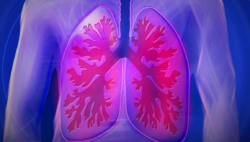Valve Surgery
As the air sacs in your lung get larger, your lung can fill with too much air every time you breathe in.
“In some patients with overaerated lungs, if a portion of the lung is removed, they may feel a lot better. There’s less trapping of air,” says Albert A. Rizzo, MD, a pulmonologist in Delaware and chief medical officer of the American Lung Association.
Because of that, the standard treatment has been to take out the damaged part of your lung with surgery, but valve surgery is now another option.
“Your surgeon can use a bronchoscope to put a one-way valve in your airway. This allows the overexpanded part of your lung to release air out of the airway, but not to let air in,” Rizzo says.
Combination Therapy
COPD medications, like long-acting beta-2 agonists (LABAs) and long-acting muscarinic antagonists (LAMAs), can be used together to offer more relief of your symptoms.
Both types of drugs make your airways smaller. “You could start out with a LABA and add a LAMA later, but you should not hesitate to start treatment with both as a combination,” Rizzo says.
“You can now get combinations of all of your drugs in one inhaler, so it’s a more convenient way to deliver your medication,” says Umur S. Hatipoglu, MD, director of the COPD Center at the Cleveland Clinic in Ohio.
Pulmonary Rehab
If your COPD symptoms have affected your quality of life, led to too much weight loss, or you’ve become weak and less active, pulmonary rehabilitation may help.
“In pulmonary rehab, you learn how to exercise, get the right vaccinations, and get nutritional counseling. It’s not something you have to do indefinitely. It’s maybe three times a week, usually for an hour. You can work out on the machines and weights with a trainer. A lot of people with COPD really benefit from these programs,” Rizzo says.
Pulmonary rehab also may include visits with a counselor to deal with your stress or emotions, support groups with others who have COPD, and training to learn to save energy and breathe better.
“It’s important to stay active if you have COPD, keep your weight under control, get vaccines every year, and speak up if you have any problems,” Rizzo says. “And don’t smoke. Your caregivers should understand that they should not smoke around you.”
IL-5 drugs
Doctors can use blood tests to divide people with COPD into smaller groups to prescribe more targeted treatments for them, Hatipoglu says.
For example, one group includes people with eosinophilia, a high number or percentage of white blood cells called eosinophils in their blood. Eosinophilia is more common in asthma, but some people with COPD have a high amount of these white blood cells, too.
If your levels are above 300, a new group of biologic drugs called IL-5 antagonists might work well for you. (Your doctor can give you a simple blood test to check your eosinophil levels.) For now, they’re approved only for severe asthma, not COPD, but “new trials of the drugs for people with COPD and high eosinophil counts look promising,” Hatipoglu says.
Stem Cell Therapy
Emphysema is one of the major health problems involved in COPD. Over many years, your lungs become damaged and diseased. Sacs inside them called alveoli grow too large. Their tissue breaks down, and that causes severe shortness of breath.
“The idea behind this therapy is that you take stem cells and use them to create new alveolar cells. It’s going to become a reality for treating COPD, but we’re not there yet,” Hatipoglu says.
You may hear about stem cell therapy clinics that claim to treat or cure COPD, but steer clear of them for now. “Don’t go to any facility that offers you bone marrow or stem cell transplant therapy for COPD. Is there hope for stem cell therapy for COPD? Absolutely. There are two or three clinical trials going on now that are awaiting results,” he says.






Leave a Reply